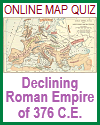| Growth and Transformation—U.S. History Workbook |
|---|
| United States History ↣ American History Workbooks ↣ U.S. History Workbooks for High School |
|
This particular workbook covers the Industrial Revolution, 19th-century inventors and inventions, the revolution in agriculture, Andrew Carnegie, John D. Rockefeller, the rise of corporations and monopolies, the growth of cities (urbanization), agrarian distress, populism, railroad regulation, reform movements, Plessy v. Ferguson, Booker T. Washington, W.E.B. Du Bois, the closing of the Western frontier, the Indian wars, the California Gold Rush, Wounded Knee, the Dawes Act, American imperialism, the Spanish-American War, construction of the Panama Canal, Seward's Folly, the Open Door policy, and much, much more. This free PDF United States History workbook is 29 pages in length. The answer key is below. Click here to print. |
 |
    |
|
1 Technology and Change 1. A - First World War 2. B - 440,000 3. Samuel F.B. Morse 4. Alexander Graham Bell 5. C - Cotton gin 6. A - Ditching machine 7. Thomas Edison 8. Mesabi 2 Carnegie and the Era of Steel 1. Andrew Carnegie 2. Answers will vary 3 Corporations and Cities 1. Answers will vary 2. B - Create limited opportunities for internal corporate expansion 3. D - trusts 4. D - John D. Rockefeller 5. Cornelius Vanderbilt 6. Answers will vary 4 Railroads, Regulation, and the Tariff 1. Rail lines extended cheaper freight rates to large suppliers by rebating a portion of the charge 2. Interstate commerce Act 3. It had little enforcement power 4. He regarded tariff protection as an unwarranted subsidy to big business, giving the trusts pricing power to the disadvantage of ordinary Americans 5. A - Benjamin Harrison 6. Increased the already high tariff rates 7. It led to high retail prices that triggered widespread dissatisfaction with the Republicans 8. Forbade all combinations (trusts and monopolies) in restraint of interstate trade and provided several methods of enforcement with severe penalties 5 Revolution in Agriculture 1. A shift from hand labor to machine farming, and from subsistence to commercial agriculture 2. Cyrus McCormick 3. (Must list four) - Automatic wire binder, threshing machine, mechanical reaper, combine (reaper-thresher), mechanical planter, mechanical cutter, mechanical husker, mechanical sheller, cream separator, manure spreader, potato planter, hay drier, poultry incubator, etc. 4. Allotted public land to each state for the establishment of agricultural and industrial colleges 5. Mark Carleton 6. Conquered the dreaded hog cholera 7. George Mohler 8. Californian who produced scores of new fruits and vegetables 9. Stephen Babcock 10. George Washington Carver 11. Answers will vary 6 The Divided South 1. C - South 2. Plessy v. Ferguson 3. Booker T. Washington 4. W.E.B. Du Bois 5. Both major political parties were uninterested in the issue and scientific theory of the time generally accepted black inferiority 7 The Last Frontier 1. Native Americans 2. Homestead Act of 1862 3. Promontory Point in Utah 4. B - Six days 5. California 6. Texas and Kansas 8 The Plight of the Native Americans 1. Sioux of the Northern Plains and Apache of the Southwest 2. He led a small detachment of cavalry and encountered a vastly superior force of Sioux and their allies on the Little Bighorn River; Custer and his men were completely annihilated 3. A ghost dance ritual on the Northern Sioux reservation led to an uprising and the massacre of nearly 300 Sioux men, women, and children 4. B - Geronimo 5. Helen Hunt Jackson 6. Reversed U.S. Native-American policy, permitting the president to divide up tribal land and parcel out 65 hectares of land to each head of a family; allotments held in trust by the government for 25 years; lands not distributed were offered for sale to settlers 7. Reversal of U.S. Native-American policy; attempted to protect tribal and communal life on the reservations 9 Ambivalent Empire 1. They felt that to safeguard its own interests, the United States had to stake out spheres of economic influence as well 2. Used to assert that the United States had a right and duty to extend its influence and civilization around the globe 3. Alaska 4. Spanish-American War 5. Maine 6. commodore George Dewey 7. 1946 8. Queen Liliuokalani 9. Pearl Harbor, which would become the major U.S. naval base in the central Pacific 10. democratic self-government 10 The Canal and the Americas 1. A - Colombia 2. Colonel George W. Goethals 3. American military intervention to provide a favorable environment for U.S. investment 4. Francisco "Pancho" Villa 5. Secretary of State James G. Blaine 6. Franklin D. Roosevelt 11 United States and Asia 1. Open Door (equality of trading opportunities between foreign nations doing business in China) 2. Chinese insurgents seized Beijing and attacked the foreign legations there 3. A struggle for power and influence in the northern Chinese province of Manchuria 12 J.P. Morgan and Finance Capitalism 1. J.P. Morgan 2. He ended price wars to their disadvantage 3. Federal Reserve System |
| United States History ↣ American History Workbooks ↣ U.S. History Workbooks for High School |








